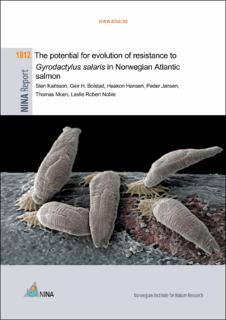| dc.description.abstract | The ectoparasite, Gyrodactylus salaris, was introduced to Norway in the early 70’s, and has since then been found in 51 salmon rivers. Wherever the parasite has been introduced in Norway, the Atlantic salmon populations have been reduced to very low levels. The policy of management authorities is to eradicate the parasite. Gyrodactylus salaris has so far been confirmed eradicated from 38 rivers. In addition 5 rivers have been treated but have not yet been confirmed free from the parasite, and eight rivers have not yet been treated. In this report we review relevant knowledge to evaluate the possibility for Atlantic salmon in Norway to naturally develop resistance or to develop resistance from selective breeding, and the possible consequences for the Atlantic salmon populations. Our main focus has been to give a summary of knowledge about the genetic basis for developing resistance, the most plausible time frame for such resistance to develop, the effects of migration, the probability of further spreading of the parasite and how this can affect genetic variation, and the genetic integrity and productivity of the salmon populations. We have also evaluated different strategies for breeding for resistance. As a basis for the evaluation of a possible resistance against G. salaris a large part of the report is devoted to a review of the general biology of the parasite (G. salaris) and the host (Atlantic salmon), and the evolutionary mechanisms behind host-parasite interactions. We conclude that there is a genetic basis for developing resistance against G. salaris in Norwegian Atlantic salmon, but the timeframe to obtain a resistance to maintain viable populations would probably be on the order of hundreds of years or longer. A selective breeding program would probably speed up the process, but would require specific considerations for maintaining genetic integrity and genetic variation. Without supplementary stocking, G. salaris infected populations are not expected to reach a productivity at the level of the spawning target, and yield a harvestable surplus, until they have developed resistance against G. salaris. A strategy of developing resistance against G. salaris as opposed to eradicating the parasite will increase the risk of further spread of the parasite to additional rivers containing salmon that are susceptible to G. salaris. This would again lead to low natural productivity in consecutive infected stocks in the unforeseeable future. | |
